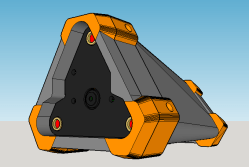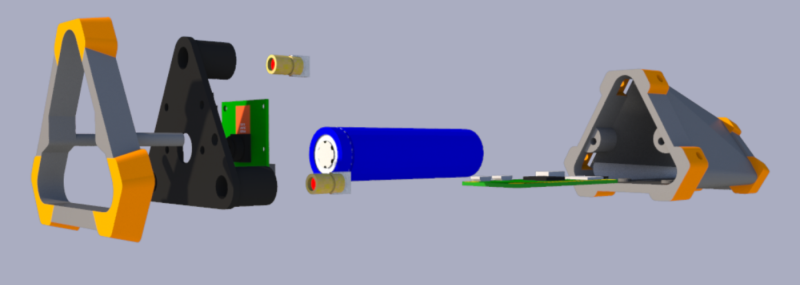The interesting thing about submissions for The Hackaday Prize is seeing unusual projects and concepts that might not otherwise pop up. [ken conrad] has a curious but thoughtfully designed idea for Raspberry Pi-based SmartZoom Imaging that uses a Pi Zero and camera plus some laser emitters to create a device with a very specific capability: a camera that constantly and dynamically resizes the image make the subject appear consistently framed and sized, regardless of its distance from the lens. The idea brings together two separate functions: rangefinding and automated zooming and re-sampling of the camera image.
 The Raspberry Pi uses the camera board plus some forward-pointing laser dots as a rangefinder; as long as at least two laser dots are visible on the subject, the distance between the device and the subject can be calculated. The Pi then uses the knowledge of how near or far the subject is to present a final image whose zoom level has been adjusted to match (and offset) the range of the subject from the camera, in effect canceling out the way an object appears larger or smaller based on distance.
The Raspberry Pi uses the camera board plus some forward-pointing laser dots as a rangefinder; as long as at least two laser dots are visible on the subject, the distance between the device and the subject can be calculated. The Pi then uses the knowledge of how near or far the subject is to present a final image whose zoom level has been adjusted to match (and offset) the range of the subject from the camera, in effect canceling out the way an object appears larger or smaller based on distance.
We’ve seen visible laser dots as the basis of rangefinding before, but never tied into a zoom function. Doubtlessly, [ken conrad] will update his project with some example applications, but in the meantime we’re left wondering: is there a concrete, practical use case for this unusual device? We have no idea, but we’d certainly have fun trying to find one.




















i built a similar device back in 2010 that did the same thing, except we combined it with a pan tilt rig and we were able to create a point cloud using trig
With the addition of pan/tilt to keep an object in view of camera, yes! As is, object has to be moving toward or away from camera. With the addition of a auto-pan/tilt mechanism, object could be tracked from left to right and still remain in focus. The Jevois ( http://jevois.org/ ) and smartzoom described above could be tied to the arduino panner project in http://www.instructables.com/id/Panner-With-Arduino/ to provide automatic in focus object tracking, at least within the limits of the camera lens used.
Might you be able to use passive auto focus code to help train the system? For when there is no laser return.
So that’s why the Predator’s gun used that triangle with dots pattern…
+1
Good call. Now someone will take this further for a deer hunting scope/rangefinder/elevation compensator.
Could kickup the game of basketball/soccer/football a notch — if “stays on target” to much, then sports ball deflates do to laser puncturing ball. — free turnover!
You may be able to market this to some YouTubers. I have seen some terrible auto focus shots. It would need a better camera though, and as others have mentioned would be more versatile with a pan and tilt rig too.
Focus you F…
No practical use??? You could shoot some really psychedelic video for a start. Lots of security cameras have motion tracking elements that this could become a hardware component to.
With object recognition, you don’t need the rangefinder. I used OpenCV to track and maintain target in pan/tilt and zoom with a cctv camera.It just keeps the target centred and taking up 2/3rds of the screen height.
It was tracking people or faces.
Only issue I had was that the HoG person tracker was easily confused by vertical lines, such as railings…
Yes, but do need rangefinder to work the autofocus in order to avoid going heavy on the trig computations and/or using cloud as noted in first post.
The other unspoken thing about the 2nd post is could do this for around $200.00.
Change the camera, and you’ll need something to run OpenCV on — the Jevois has that.
Diy or lens with motor mount would still be needed for Jevois to “focus” on non-fixed targets.
OpenMV ( http://openmv.io/ ) doesn’t have the same frame rate (> 60 fps).
Using the Jetson TX ups the cost dramatically.
Easier to just figure out how to modify/integrate the Jevois and laser rangefinder onto http://www.diyrc.com/wireless.htm than take the ~$57 https://www.mistralsolutions.com/product-engineering-services/products/sd820-nano-som/ and build a complete hardware/software package from scratch. Not that there is anything wrong with doing it from scratch. ;)
Interesting. This functionality is very similar to how the original maverick missile targeted tanks. Once lock was established on an armored vehicle and the projectile was released, the zoom system would track back and the processor would count pixels from the various extents of the image for navigation.
This is an unbelievably old technology. Before the Maxxum line hit many of the earliest autofocus systems for SLRs used on-lens laser rangefinders so they’d work on select manual focus cameras.
Nevermind, it looks like even then it was linear CCD parallax.
I develop prototypes, and always thinking on new toys. However this one is not in my field of expertise- I can discuss a need, but not how to do it. So-
Imagine a zoom security camera. Develop an app that adds an overlay on the screen that always represents a specific dimension- say 18″, This would simply be two lines or a box, and it correlates to the zoom level of the camera so that it always stays the same size. Using the dimension of 18″ and the zoom, the distance can be calculated and displayed on the screen
The is is not unlike mechanical range tools built into rifles scopes, but would be quite versatile. I am currently building a “range camera”. Sits on the table at shooting range and displays your target and hits on a laptop screen. Uses a 36X PTZ camera, all parts contained in a case. On a range, distances are known. But in the field, they are “guesstimated”. A device like this in the field could be used to scan a probably field, lock on to movement- and with a rangefinder build in, tell you haw far as well as where.